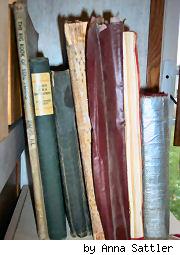The (Book) Doctor is In!
/A special treat for readers today: my good friend Meredith Sommers has written a guest post for The Scop! I met Meredith when she was getting her MLIS in preservation; she now works as a librarian and archivist at Milligan College. Behold her book-fixing powers:
Pretty neat, eh? I asked Meredith to share some advice on the care and feeding of books, here's what she came back with ...
* * *
 First off, thanks to Jonathan for the chance to guest post. I'm excited to have the opportunity to think about the care of books, which occupies a surprisingly small portion of my life these days. With the exception of unique archival items, our school's collection is selected for use. When our books get old and ratty, we buy new ones (because most of them can be replaced less expensively than they can be repaired). I'm finding lately that this mentality is bleeding into my personal life; my home library is greatly shrunken from its heyday, and I'm much less emotionally attached to most of my books than I once was[1. 1. Last week, the book I was reading was soaked when a pipe burst, and I tossed it into the garbage without a second thought because I could get another copy so much more easily than I could return the soaked one to a readable state].
First off, thanks to Jonathan for the chance to guest post. I'm excited to have the opportunity to think about the care of books, which occupies a surprisingly small portion of my life these days. With the exception of unique archival items, our school's collection is selected for use. When our books get old and ratty, we buy new ones (because most of them can be replaced less expensively than they can be repaired). I'm finding lately that this mentality is bleeding into my personal life; my home library is greatly shrunken from its heyday, and I'm much less emotionally attached to most of my books than I once was[1. 1. Last week, the book I was reading was soaked when a pipe burst, and I tossed it into the garbage without a second thought because I could get another copy so much more easily than I could return the soaked one to a readable state].
That said, there are some books worth keeping forever and handing down. And the good news is, books are sturdy. If they're made of quality materials (read: not mass-market paperbacks printed on acidic paper), and given a modicum of care, they'll last a really long time. Below are some basic guidelines for keeping your books safe:
Environment - Books are comfortable when people are comfortable. They'll do best around 70 degrees F, and 30-50% relative humidity. The key, though, is consistency. Don't put your treasures in the uninsulated attic where the temperature fluctuates wildly with the seasons, or the damp basement. Keep them away from flood-prone areas (basement, again). Built-in bookcases flanking the fireplace? Not for the heirlooms. Light causes fading.
Storage - Books should be on the shelf, standing straight up. Leaning stresses the spine, and eventually leaves them mangled. Keep the shelf full or use a bookend, but don't pack it so tightly that it's a struggle to remove a volume. If you have to pack books away, lay them flat in the box or rest them on their spines. Resting on the foreedge stresses the hinges and can pull the textblock out of the case. And if you have to put that box in the basement (it happens), keep it up high and use a plastic bin with a snap-on lid for extra protection.
Use - Be gentle. Wash your hands. Finger oil and dirt can build up remarkably. To remove the book from the shelf, push in the volumes to either side so that you can grasp the middle of the spine (rather than using one finger on the top of the spine to tip it out). Use a paper bookmark rather than a thicker metal or leather one to avoid distending the pages (similarly, no dog-earing, and no paper clips – which have the added benefit of rust). No Post-its; the adhesive leaves a residue. If you have to annotate, use pencil. Support the covers; don't force the book to open flat. Never lay it open and face-down. Keep away from food or drink.
On the subject of repairs, it's hard for me to recommend DIY jobs. So many at-home interventions go so badly. If it's really beloved, call a conservator. But a few tips, for things worth fixing, but not worth bringing in the big guns:
 Water - Get it dried out. Stand the book on its end with the pages fanned out and keep air circulating and the lights on. Stick paper towels in between every 10 pages or so, and change the towels frequently. The key is to avoid mold, which can set in very, very quickly. The pages will buckle, but it'll still be readable.
Water - Get it dried out. Stand the book on its end with the pages fanned out and keep air circulating and the lights on. Stick paper towels in between every 10 pages or so, and change the towels frequently. The key is to avoid mold, which can set in very, very quickly. The pages will buckle, but it'll still be readable.
Tears - Never, ever use Scotch tape. Give it 20 years, and it'll be cracked and brittle and yellow -- as will the paper underneath. Filmoplast is lovely (but pricey), and a roll will probably last the rest of your life. Line the paper up and use small pieces of tape to match the tear's contours. Fold the tape over the edge of the page, and repeat up the back of the tear.
Loose Hinges - Often the result of storing a book on its fore-edge. The text block comes apart, just a little, from the cover. It can be reattached with a bit of acid-free glue (PVA, polyvinyl acetate is good. Check the scrapbook supplies section of Michael's or similar) applied with a very thin knitting needle[2. 2. University of Illinois - Urbana-Champain has a great tutorial].
Torn spine - Sorry. I have no suggestions beyond professional help. Please, though, no duct tape.
* * *
Me again. If you want to see more of Meredith's book repair wizardry, click here. She also sent along the following links for (much) more information on the subject:
American Institute for Conservation's Caring for Your Treasures
Northeast Document Conservation Center's preservation leaflets








